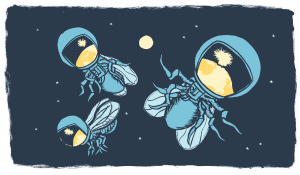FRIDAY, 27 APRIL 2012
She-male SnakesScientists from Oregon state University have found that placing oestrogen capsules in male snakes makes them attractive to other males and even preferred over the smaller females. This gives an important insight into how the male snakes seek out a partner. Every spring, red-sided garter snakes emerge from limestone caves to form their unique ‘mating balls’, which involve one female becoming swarmed by several males during mating. Oestrogen is important for producing the female sex pheromones released into the air by females. By flickering their tongues to sense the pheromones, males can assess the species, sex, size, age and reproductive conditions of the female, helping them choose their mate. Surprisingly, the oestrogen capsules were able to fool the snakes into believing they had found a suitable partner. This link between oestrogen and mating helps explain the phenomenon of ‘she-males’—males who are found to produce female sex pheromones in response to exposure from oestrogen mimicking pollutants in the environment. Martha Stokes
Levitating Flies
Studying the consequences of weightlessness is no longer confined to experiments in space. Scientists from Nottingham University have successfully studied the effects of weightlessness on fruit flies without leaving their lab. The researchers created their own microgravity environment using an extremely powerful super-conducting magnet. Fruit flies and other organisms are diamagnetic, which means they are repelled by magnetic fields. Normally this is too weak to be noticed but inside the hollow core of the scientists’ magnet, the magnetic field was just strong enough to balance out gravity, making the flies essentially weightless. The potential to use this ‘diamagnetic levitation’ for studying microgravity was first shown in 2000 when Dutch researchers levitated several small animals, including a live frog. The fruit fly study now shows that this technique effectively mimics conditions in space, as the flies’ responses inside the magnet corresponded perfectly with that of flies living in the International Space Station. Understanding the consequences of weightlessness is very important for enabling long-term space stays, but investigating it has been very expensive. The new method greatly reduces the research costs, so these levitating flies may well represent an important step towards deep space exploration. Emma Bornebroek
That’s a Rap
Researchers from Purdue University have designed a medical implant for monitoring bladder and blood pressure. However, this is no ordinary device; instead of using batteries, it is powered by the acoustic energy of rap music. The mini device contains a small lever capable of converting vibrations into electrical power. The lever vibrates and charges a capacitor while the music plays at the low frequencies usually found in rap. When the lever stops vibrating, the stored energy triggers a pressure sensor to take a reading and the data is transmitted back to a receiver via a radio signal. If hip-hop is not your thing, then slight tweaks to the lever length or thickness would allow it to respond to a range of musical genres. Previous devices required precise alignment between sensor and receiver, short transmission ranges and complicated circuitry. This novel device overcomes these challenges and has the bonus of being powered by your favourite tunes. Yvonne Collins



